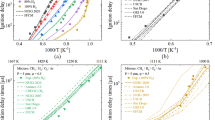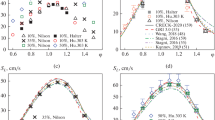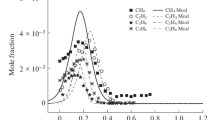Abstract
While fuel combustion in oxygen-enriched environments provides a number of significant advantages, such as reduced nitrogen oxide emissions and high carbon dioxide purity for carbon sequestration, it is characterized by different physico-chemical oxidation behavior than combustion in air. Compared to nitrogen, carbon dioxide has different specific heat and effective Lewis number, and is chemically more active. Therefore, chemical mechanisms developed for the oxidation of fuel/air mixtures can fail to predict targets of interest for oxy-combustion accurately. In this study, a chemical mechanism of methane, which has been previously validated with data from experiments using air, is evaluated in terms of its prediction accuracy at oxy-conditions by comparing against available literature data. The validation takes various combustion properties into account, including ignition delay times, laminar burning velocities, and extinction strain rates, and covers a wide range of experimental conditions with respect to temperature, pressure, equivalence ratio, and carbon dioxide concentration. As additional targets, extinction strain rates of non-premixed oxy-methane flames are determined in a counterflow burner at conditions, where literature data have not yet been reported. The extensive validation demonstrates that the mechanism is able to describe oxy-methane combustion with reasonable prediction accuracy. For further insights into the underlying kinetics of diffusion flames of methane in oxy-atmosphere compared to its oxidation in air, reaction path and sensitivity analyses are performed using the validated mechanism. Notable differences between both combustion regimes are observed in the branching ratios of H-abstraction reactions by OH and H radicals and in the consumption channels of singlet methylene, which is a key species in the formation of polycyclic aromatic hydrocarbons.










Similar content being viewed by others
References
Benedetto, A.D., Cammarota, F., Sarli, V., Russo, G., Salzano, E.: Explosion behavior of CH\(_4\)/O\(_2\)/N\(_2\)/CO\(_2\) and H\(_2\)/O\(_2\)/N\(_2\)/CO\(_2\) mixtures. Int. J. Hydrog. Energy 34, 6970 (2009)
Blanquart, G., Pepiot-Desjardins, P., Pitsch, H.: Chemical mechanism for high temperature combustion of engine relevant fuels with emphasis on soot precursors. Combust. Flame 156, 588 (2009)
Burke, M., Chaos, M., Ju, Y., Dryer, F., Klippenstein, S.: Comprehensive H\(_{2}\)/O\(_{2}\) kinetic model for high-pressure combustion. Int. J. Chem. Kinet. 44, 444 (2012)
Cai, L., Pitsch, H.: Optimized chemical mechanism for combustion of gasoline surrogate fuels. Combust. Flame 162, 1623 (2015)
Cai, L., Minwegen, H., Beeckmann, J., Burke, U., Tripathi, R., Ramalingam, A., Kröger, L., Sudholt, A., Leonhard, K., Klankermayer, J., Heufer, K., Pitsch, H.: Experimental and numerical study of a novel biofuel: 2-butyltetrahydrofuran. Combust. Flame 178, 257 (2017a)
Cai, L., Kruse, S., Felsmann, D., Thies, C., Yalamanchi, K., Pitsch, H.: Experimental design for discrimination of chemical kinetic models for oxy-methane combustion. Energy Fuels 31, 5533 (2017b)
Cai, L., Ramalingam, A., Minwegen, H., Heufer, K., Pitsch, H.: Impact of exhaust gas recirculation on ignition delay times of gasoline fuel: an experimental and modeling study. Proc. Combust. Inst. 37, 639 (2019a)
Cai, L., Minwegen, H., Kruse, S., Ramalingam, A., Hesse, R., Beeckmann, J., Leonhard, K., Heufer, K., Pitsch, H.: Exploring the combustion chemistry of a novel lignocellulose-derived biofuel: cyclopentanol. Part II: experiment, model validation, and functional group analysis. Combust. Flame 210, 134 (2019b)
Cai, L., Kröger, L., Döntgen, M., Leonhard, K., Narayanaswamy, K., Sarathy, S., Heufer, K., Pitsch, H.: Exploring the combustion chemistry of a novel lignocellulose-derived biofuel: cyclopentanol. Part I: quantum chemistry calculation and kinetic modeling. Combust. Flame 210, 490 (2019c)
Chan, Y., Zhu, M., Zhang, Z., Liu, P., Zhang, D.: The effect of CO\(_2\) dilution on the laminar burning velocity of premixed methane/air flames. Energy Proc. 75, 3048 (2015)
Chen, Z., Qin, X., Xu, B., Ju, Y., Liu, F.: Studies of radiation absorption on flame speed and flammability limit of CO\(_2\) diluted methane flames at elevated pressures. Proc. Combust. Inst. 31, 2693 (2007)
de Persis, S., Foucher, F., Pillier, L., Osorio, V., Gokalp, I.: Effects of O\(_2\) enrichment and CO\(_2\) dilution on laminar methane flames. Energy 55, 1055 (2013)
Frenklach, M., Wang, H., Yu, C.L., Goldenberg, M., Bowman, C., Hanson, R., Davidson, D., Chang, E., Smith, G., Golden, D., Gardiner, W., Lissianski, V.: GRI-Mech—an optimized detailed chemical reaction mechanism for methane combustion. http://combustion.berkeley.edu/gri-mech/ (1999). http://combustion.berkeley.edu/gri-mech/new21/version12/text12.html
Hargis, J., Petersen, E.: Methane ignition in a shock tube with high levels of CO\(_2\) dilution: consideration of the reflected-shock bifurcation. Energy Fuels 29, 7712 (2015)
Kim, T., Park, J., Park, H., Park, J., Park, J., Lim, I.: Chemical and radiation effects on flame extinction and NO\(_x\) formation in oxy-methane combustion diluted with CO\(_2\). Fuel 177, 235 (2016)
Kishore, V., Duhan, N., Ravi, M., Ray, A.: Measurement of adiabatic burning velocity in natural gas like mixtures. Exp. Therm. Fluid Sci. 33, 10 (2008)
Koroglu, B., Pryor, O., Lopez, J., Nash, L., Vasu, S.: Shock tube ignition delay times and methane time-histories measurements during excess CO\(_2\) diluted oxy-methane combustion. Combust. Flame 164, 152 (2016)
Li, X., Jia, L., Onishi, T., Grajetzki, P., Nakamura, H., Tezuka, T., Hasegawa, S., Maruta, K.: Study on stretch extinction limits of \(\text{ CH }_4\)/\(\text{ CO }_2\) versus high temperature \(\text{ O }_2\)/\(\text{ CO }_2\) counterflow non-premixed flames. Combust. Flame 161, 1526 (2014)
Maruta, K., Abe, K., Hasegawa, S., Maruyama, S., Sato, J.: Extinction characteristics of \(\text{ CH }_4\)/\(\text{ CO }_2\) versus \(\text{ O }_2\)/\(\text{ CO }_2\) counterflow non-premixed flames at elevated pressures up to 0.7 MPa. Proc. Combust. Inst. 31, 1223 (2007)
Mazas, A., Lacoste, D., Schuller, T.: Experimental and Numerical investigation on the laminar flame speed of \(\text{ CH }_4/\text{ CO }_2\) mixtures diluted with \(\text{ CO }_2\) and \(\text{ H }_2\text{ O }\). In: Proceedings of the ASME Turbo Expo, GT2010-22512 (2010)
Metcalfe, W., Burke, S., Ahmed, S., Curran, H.: A hierarchical and comparative kinetic modeling study of C\(_1\)-C\(_2\) hydrocarbon and oxygenated fuels. Int. J. Chem. Kinet. 45, 638 (2013)
Narayanaswamy, K., Blanquart, G., Pitsch, H.: A consistent chemical mechanism for oxidation of substituted aromatic species. Combust. Flame 157, 1879 (2010)
Narayanaswamy, K., Pitsch, H., Pepiot, P.: A component library framework for deriving kinetic mechanisms for multi-component fuel surrogates: application for jet fuel surrogates. Combust. Flame 165, 288 (2016)
Pitsch, H.: A C++ computer program for 0D combustion and 1D laminar flame calculations. http://www.itv.rwth-aachen.de/downloads/flamemaster/ (1990)
Pryor, O., Koroglu, B., Barak, S., Lopez, J., Ninnemann, E., Nash, L., Vasu, S.: Ignition delay times of high pressure oxy-methane combustion with high levels of CO\(_2\) dilution. In: Proceedings of the ASME Turbo Expo, GT2017-63666 (2017)
San Diego mechanism, Version released on 2014/10/04. http://web.eng.ucsd.edu/mae/groups/combustion/mechanism.html (2014). http://web.stanford.edu/group/haiwanglab/JetSurF/JetSurF2.0/index.html
Seshadri, K., Williams, F.: Laminar flow between parallel plates with injection of a reactant at high reynolds number. Int. J. Heat Mass Transf. 21, 251 (1978)
Acknowledgements
This work was performed as part of the collaborative research center SFB/Transregio 129 “Oxyflame”, which is funded by the German Research Foundation (DFG). The authors would like to thank Mr. Kiran K. Yalamanchi for his support with numerical calculations.
Author information
Authors and Affiliations
Corresponding author
Ethics declarations
Conflict of interest
This study was funded by the German Research Foundation (DFG). The authors declare that they have no conflict of interest.
Electronic supplementary material
Below is the link to the electronic supplementary material.
Rights and permissions
About this article
Cite this article
Cai, L., Kruse, S., Felsmann, D. et al. A Methane Mechanism for Oxy-Fuel Combustion: Extinction Experiments, Model Validation, and Kinetic Analysis. Flow Turbulence Combust 106, 499–514 (2021). https://doi.org/10.1007/s10494-020-00138-w
Received:
Accepted:
Published:
Issue Date:
DOI: https://doi.org/10.1007/s10494-020-00138-w




